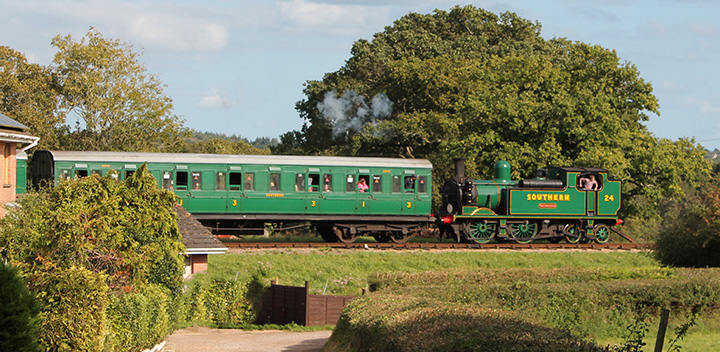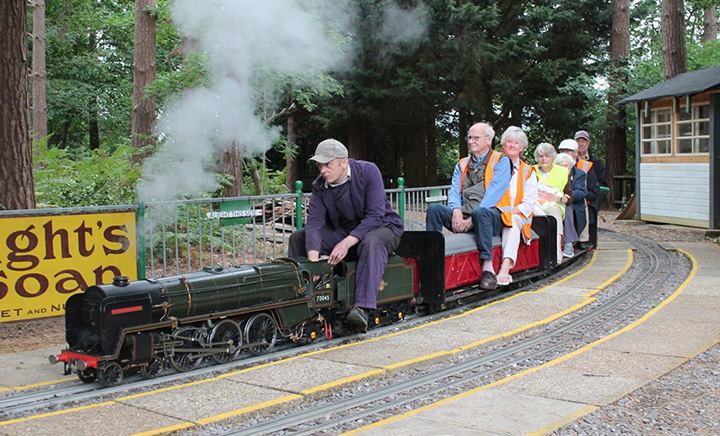Railway & Transport Club
We meet at 7:30 pm (new time from January 2023) on the 3rd Tuesday of each month, except July, August and December. Contact: John Soer or Jim Dunning.
The Club has over 40 members and enables men and women of all ages to share their common interest.
We meet in the Bradbury Centre of the Methodist Church, in Rose Street (Peach Place), where members enjoy a wide range of good quality presentations on transport topics, including heritage and steam railways, with the opportunity for refreshments and time for a chat.
Future Programme
Note meetings are at 7.30pm in the Bradbury Centre (Hall or Luke).
| 16 Sept | ‘Train Ferries of WW1 and WW2’ - Gordon Adams We welcome back Gordon Adams who gave us an enjoyable and well researched talk on Eastleigh last year. In the year which marks its 80th anniversary we hear about the build-up that led to VE Day. |
| 21 October | Details to be supplied. |
| 18 November | Annual General Meeting - followed by Members Evening |
Meeting Reports
On April 15th Stuart Duddy, one of the Directors of the Isle of Wight Steam Railway, told us the fascinating history of the once extensive railway system on the Island and the history of the present-day Steam Railway. At its maximum extent there were 45.25 route miles but even at the grouping in 1923 they were still operated by several rival companies. The first line from Newport to Cowes opened in 1862. It was not until 1880 though that the railway reached Ryde Pier Head. We also heard of the short-lived train ferry from Langstone near Hayling to Bembridge. The network was finally completed in 1900, but closures started in the 1950s and today there is only the 8.5 mile Ryde to Shanklin line and the Steam Railway.

The Steam Railway had its roots in the preservation of number 24 Calbourne (picture above) which was withdrawn when steam traction ended at the end of 1966. Today the engine runs on the 5.5 mile line from Smallbrook Junction, where there is a connection from the Ryde to Shanklin line, to Wooton. At the intermediate station of Havenstreet, there are engine sheds and an interactive discovery centre, an exhibition. Stuart described the engines and carriages, many of which date from the Victorian era.
The topic chosen by Cliff Perry MBE, our speaker on 20th May, was Train Engineering Incidents. Cliff began by outlining his career as a train engineer, during which he spent some time with Network South East which had the world's largest train fleet. Throughout his talk, Cliff emphasised the importance of engineering to the railway industry.
In the space available it is only possible to cover a few parts of Cliff's varied career. Among the highlights was his work on the HSTs. This resulted in a 25% increase in speed and a 33% increase in availability. The daily mileage of a unit doubled to 1000 miles a day. A fault with the nose end was rectified without stopping any trains.
The discovery on the track of half of the coupling between the carriages on one type of the electric units used by Network South East led to a change in specification and supplier.
Cliff spent some time discussing the causes and accidents, beginning with that at Hither Green in 1967, caused by broken rails. These were found to be caused by a deformation of the wheels due to sliding when braking on slippery rails. We heard about the latest methods, other than a visual inspection. of detecting these hazards.
Cliff's talk was full of technical detail yet presented in a very entertaining way.
On 17th June we were visited by Richard Stow and Andrew McCallum, the Chairman and Secretary of the Thames Valley branch of RailFuture an organisation which campaigns for improvements, including re-openings, to the railway system. The closures brought about by the Beeching Report in the 1960s caused widespread fury which led to the creation of a number of campaigning groups. RailFuture works with other campaigning groups many of which are affiliated to it.
Among its early successes were improvements to the North London Line which ran from Richmond to Broad Street Station. By the 1960s this line was in a deplorable state and little used. Campaigning led to British Rail introducing new trains and other improvements. Although Broad Street Station closed in 1986, the line now is a heavily used part of the London Overground and a bears little resemblance to the line of the 1960s. Current ‘wins’ include the Portishead line in Bristol and the Ashington line in Northumberland and more trains for the Elizabeth Line.
Richard and Andrew then went on to discuss in some detail the campaigns in which the Thames Valley group is involved. The first of these, East-West Rail, the reopening of the line from Oxford to Cambridge which closed in 1968, can count as half a win as it carried its first scheduled freight train on 9th June and passenger services between Oxford and Bedford will soon open. The route east of Bedford has still to be decided.
Other campaigns include access to Heathrow from both the West and the South, the opening of a station on the GWR line to serve the area around Wantage and Grove, the redoubling of parts of the Cotswold Line from Oxford to Worcester which has become very busy, and the reopening of the Cowley branch in Oxford. The key to many of its aspirations is a widening of the bridge in Botley Road, Oxford which is being carried out now. The number of questions at the end showed how much the talk had been enjoyed.
On Sunday 3rd August thirteen members of the Railway and Transport Club visited Pinewood Miniature Railway.
There were four engines in steam and club members had the opportunity to travel on trains through the woodland setting. We also saw the workshops and were able to talk to the owners about their engines. The layout includes provision for two gauges (5 inches and 7.25 inches) with straight track, curves and points. A feature of the railway is the signalling system. Progress on the replacement signal box project was noted. The side panels have been erected and the roof installed as shown in the photograph.

Refreshments were available during the most enjoyable visit which enabled members to get together in the recess between our June and September meetings. Thanks are offered to members of the Miniature Railway for their warm welcome and looking after us so well.
If you missed the trip the Railway is located in the Pinewood complex on the west side of Old Wokingham Road just north of Nine Mile Ride. Postcode RG40 3AQ. It is normally open to the public on the 3rd Sunday of the month from March to November, with Santa Specials on a Sunday in December.
John Soer and Jim Dunning
Annual Report (March 2025)
During 2024 we enjoyed a wide-ranging programme of talks with an average attendance of a little over twenty. Some that come are not Church members, but all enjoy the chance to chat to others before the meeting. Of particular note during the year was the exhibition in the meeting place during September/ October to celebrate the 175th Anniversary of the railway coming to Wokingham. The sale of old magazines, maps etc raised £100 for the Railway Children Charity.
John Soer
